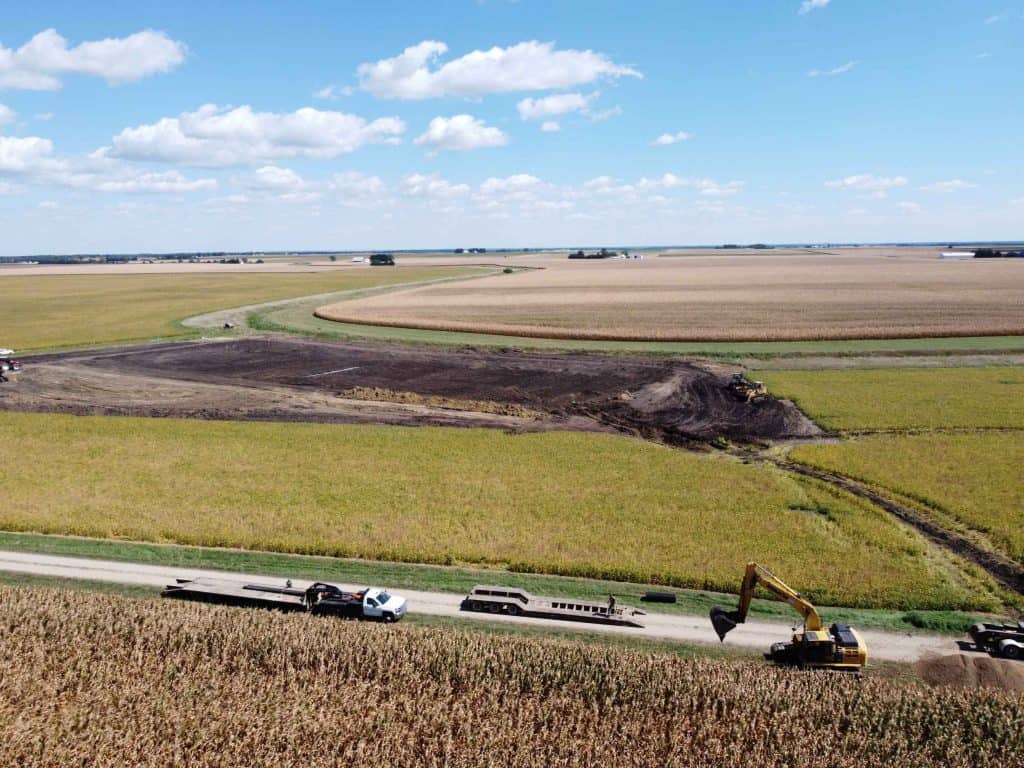SMART Wetlands
Author: Jean McGuire, Field Outreach Specialist | The Wetlands Inititative
What happens when soil, clay, plants, and water are combined using human engineering? Could this combination create smart outcomes for the landscape? Usually, there are concerns when several thousand cubic yards of soil are moved on Illinois croplands. However, in this case, it was done by design to create a constructed wetland to treat tile drainage in northwestern Marshall County.

Early stages of soil being moved in the construction process in order to reach the clay layer that serves as the base for the wetland.
Through its Smart Wetland program, the Wetlands Initiative (TWI) worked with the operator, landowner, and farm manager to design and develop a 1.8-acre wetland that captures and treats 60 acres of tile-drained row crop farmland. This practice was implemented in support of the Illinois Nutrient Loss Reduction Strategy and meeting its goals of improved soil health and water quality.

The light-colored soil is actually the unearthed clay layer that will serve as the wetland liner to reduce seepage out of the wetland.
Smart Wetlands are custom-designed and shallow, marsh ecosystems that use the naturally occurring processes in wetlands to remove nitrates from ag tile drainage water, reducing the amount of nitrogen flowing into downstream water bodies. Landowners implementing constructed wetlands can be partially reimbursed for construction costs and collect an annual rent payment under the USDA’s Conservation Reserve Program CP39 practice.

Smart Wetlands team members Dr. Jill Kostel and Mike Richolson mark the locations where small interior clay berms will be built before the topsoil is brought back to cover the clay layer.
As is the case with all Smart Wetlands, this most recent wetland project was a collaborative effort. TWI’s primary partners were Marshall-Putnam County Soil and Water Conservation District (M-P SWCD), USDA Natural Resources Conservation Service, Marshall-Putnam Farm Service Agency, Greene Farm Management Service, Inc., and McCuskey Farms. M.K. Farm Drainage Specialists, an Illinois Land Improvement Contractor Association member, installed the wetland and surrounding buffer. A portion of this project was funded by the $1.5 million Regional Conservation Partnership Program (RCPP), awarded to the Marshall-Putnam Conservation District. The RCPP funds are used for conservation projects, soil health, water and air quality improvements, nutrient loss reduction strategies, and more through the USDA EQIP and CSP programs. A full list of local partners and eligible practices can be found at https://marshallputnam.com/rcpp/.

A new tile line has been laid to connect the wetland with a tile main line from a nearby field.
Public events are planned for Summer 2022, including tours of the wetland and opportunities to talk with those who designed and built it. In the meantime, you can see photos and videos of the Smart Wetland construction at www.smartwetlands.farm.
If you think a Smart Wetland would be a great addition to your farm’s tile drainage system in the Illinois counties of Bureau, Ford, LaSalle, Livingston, Marshall, or Putnam, please contact Jean McGuire (jmcguire@wetlands-initiative.org, 515-520-3036 text or 815-239-0125).

A temporary cover has been planted over the wetland and the surrounding buffer to reduce potential erosion and weed problems until the native seed mixtures are planted this winter.